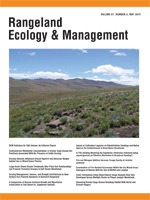Anthropogenic disturbances, wildfires, and weedy-plant invasions have destroyed and fragmented many sagebrush (Artemisia L. spp.) habitats. Sagebrush-dependent species like greater sage-grouse (Centrocercus urophasianus) are vulnerable to these changes, making habitat monitoring essential to effective management. Conventional ground inventory methods are time consuming (expensive) and have lower data collection potentials than remote sensing. Our study evaluated the feasibility of ground (0.3-mm ground surface distance [GSD]) and aerial imagery (primarily, 1-mm GSD) to assess ground cover for big sagebrush (Artemisia tridentata Nutt.) and other vegetation functional groups important in sage-grouse breeding habitat (lekking, nesting, and brood rearing). We surveyed ∼ 526 km2 of the upper Powder River watershed in Natrona County, Wyoming, USA, a region dominated by Wyoming big sagebrush (Artemisia tridentata Nutt. ssp. wyomingensis Beetle & Young) communities interspersed with narrow riparian corridors. Our study area was used year-round by sage-grouse and included 16 leks. In June 2010, we acquired aerial images (1-mm resolution) for 3 228 systematic sampling locations; additional images were acquired as rapid-succession bursts where aerial transects crossed riparian areas and for 39 riparian and 39 upland ground locations (0.3-mm resolution) within 3.2-km of leks. We used SamplePoint software to quantify cover for plant taxa and functional groups using all ground images and a systematic sampling of aerial images. Canopy cover of sage-grouse food forbs—as averaged across aerial and ground imagery around all leks—was 1.8% and 7.8% in riparian and 0.5% and 4.0% in upland areas, respectively. Big sagebrush cover was 8.7% from upland aerial images and 9.4% from upland ground images. Aerial and ground imagery provided similar values for bare ground and shrubs in riparian and upland areas, whereas ground imagery provided finer-scale herbaceous-cover data that complemented the aerial imagery. These and other image-derived archival data provide a practical basis for landscape-scale management and are a cost-effective means for monitoring extensive sagebrush habitats.
How to translate text using browser tools
1 May 2014
Assessing Greater Sage-Grouse Breeding Habitat With Aerial and Ground Imagery
Jeffrey L. Beck,
D. Terrance Booth,
Carmen L. Kennedy
ACCESS THE FULL ARTICLE
<
Previous Article
|

Rangeland Ecology and Management
Vol. 67 • No. 3
May 2014
Vol. 67 • No. 3
May 2014
big sagebrush
Centrocercus urophasianus
rangeland monitoring and assessment
sampling costs
very large scale aerial imagery




